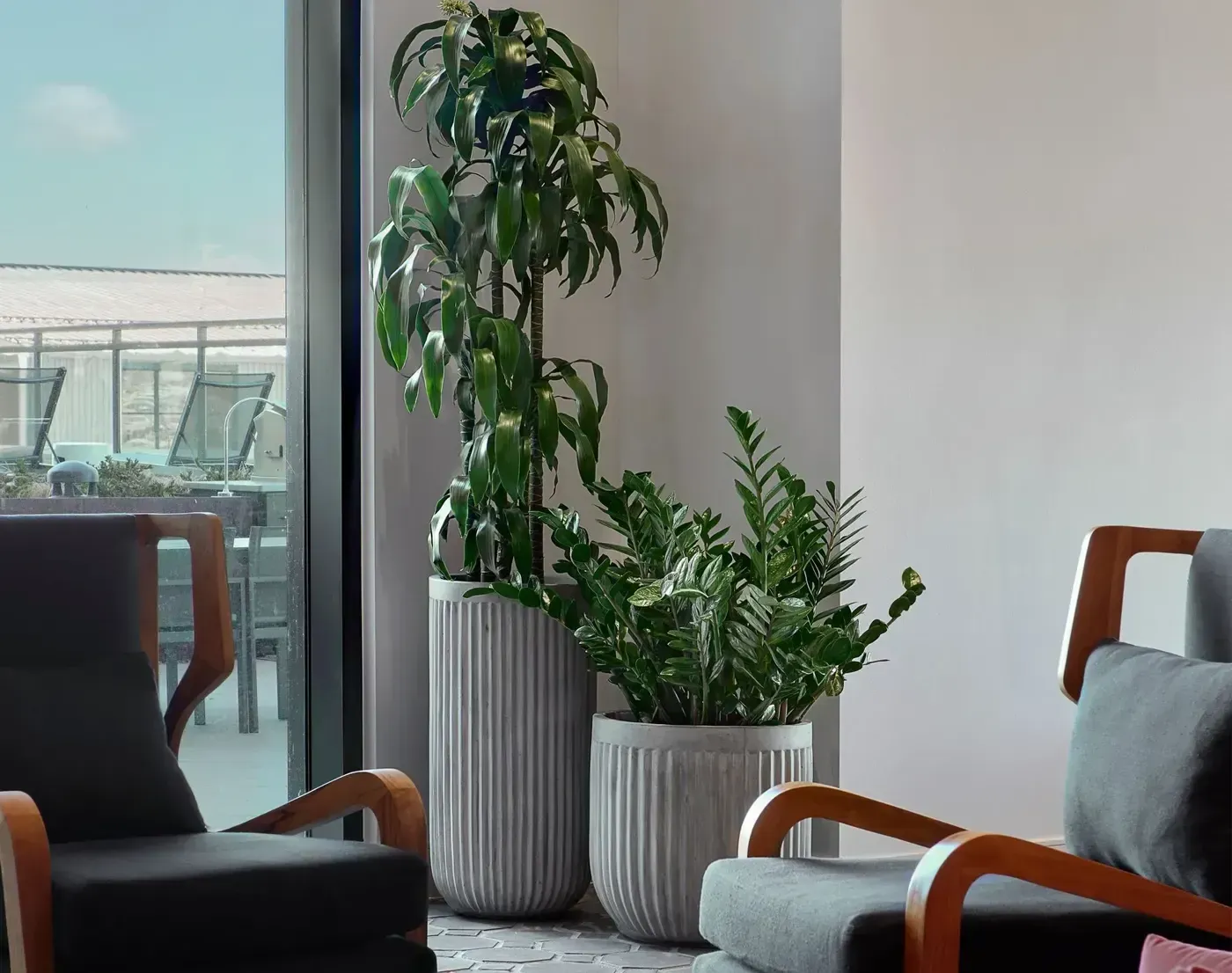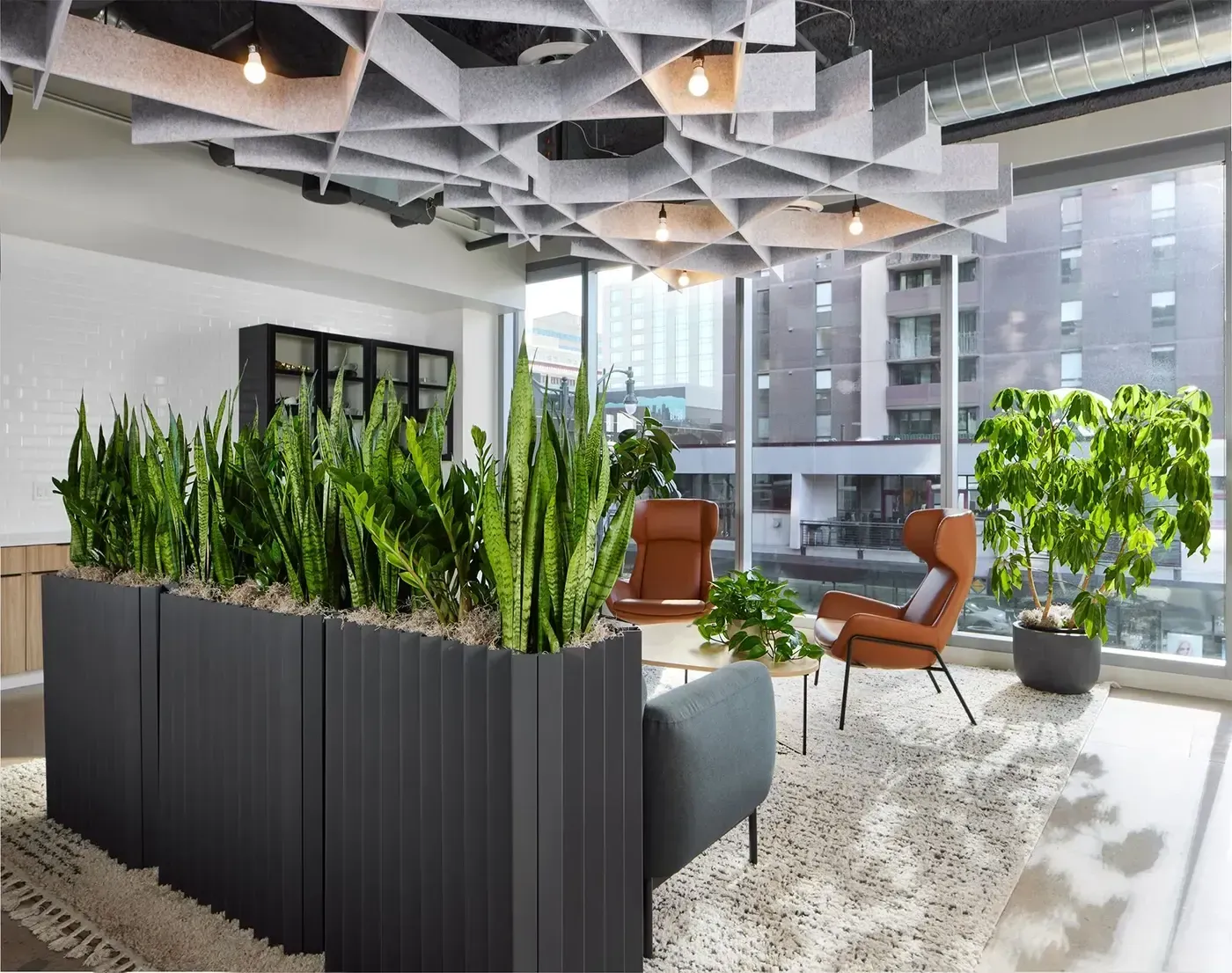What is Biophilic Design ?

Biophilic design integrates natural elements directly into architecture and interior decorating to promote health, productivity, and a sense of well-being. This concept taps into humanity’s innate desire to connect with the natural world by inviting the outdoors in.
From offices that inspire creativity to relaxing home sanctuaries, this design approach is reshaping environments with powerful results. In this article, the plantscaping experts at
Root By Design explore what makes the philosophy so impactful, including:
- The concept of biophilic design
- The difference between direct & indirect design
- The principles behind this philosophy
- The role of interior plantscaping
- The psychology behind bringing plants inside
- The future of the philosophy
What is the Concept of Biophilic Design?
Translating to “love of life,” biophilia is the human tendency to interact or be closely associated with nature. Therefore, biophilic design means increased human connectivity through the use of direct and indirect nature within a built environment.
In other words, it's a design philosophy centered around emulating nature in indoor spaces whether through plants, light, air flow, texture, and shapes. Humans have evolved to thrive and survive in natural environments, and our nervous systems have developed in response to the natural world.
The average American spends 90% of their time indoors in the built world. Being disconnected from nature can lead to increased stress, anxiety, and other health issues, which highlights the importance of maintaining a strong connection to nature for our overall well-being.
Direct vs. Indirect Design
- Direct biophilic design refers to incorporating natural elements that provide an immediate connection to nature, such as physically bringing plantlife and natural materials indoors.
- Indirect biophilic design relies on representations or abstract connections to nature rather than actual natural elements. This approach uses materials, textures, shapes, and patterns inspired by nature.
Principles of Biophilic Design
- Natural Elements: Integrating natural materials to bring nature into the space, such as wood, stone, water, greenery, and natural light.
- Natural Shapes and Forms: Using organic shapes and patterns inspired by nature to create a harmonious, flowing design, like curves, fractals, and botanical motifs.
- Natural Light and Airflow: Maximizing natural light, fresh air, and ventilation, and providing views of outdoor landscapes to improve mood and energy levels.
- Biomorphic Patterns: Incorporating textures and patterns found in nature (such as those resembling leaves, waves, or honeycombs) to subtly reinforce a connection to the natural world.
- Sensory Variability: Engaging multiple senses through natural sounds, textures, scents, and even tastes to create a fully immersive environment.
- Connection to Place: Designing spaces that reflect the local environment, culture, and landscape to foster a sense of identity and grounding within a specific location.
- Refuge and Prospect: Creating areas that offer both openness (prospect) and shelter (refuge) for safety, privacy, and comfort, helping people feel secure and relaxed.
- Environmental Dynamics: Integrating elements that change naturally (like water features, indoor plants, or light patterns) to bring a sense of rhythm, movement, and life into the space.
What Role Does Plantscaping Play in Biophilic Design?
Plantscaping embodies and amplifies the core principles of biophilic design. By introducing live plants into interior and exterior spaces, plantscaping creates a direct connection to nature, one of the fundamental principles of this philosophy.
Beyond its direct benefits, plantscaping also supports indirect and symbolic connections to nature. Thoughtfully arranged plantscapes mimic natural patterns and ecosystems, invoking the organic forms and spatial arrangements found in nature.
Ultimately,
plantscaping services are a versatile tool that integrates seamlessly into the broader framework of sustainable design. It enriches spaces by blending aesthetic beauty with functional wellness.
The Psychology Behind Bringing Plants Indoors
- Improved Air Quality
- Enhanced Well-Being
- Increased Productivity
- Cognitive Benefits
- Reduced Fatigue and Sick Building Syndrome
- Healing Environments
- Natural Light and Academic Performance
- Sustainability and Well-Being
Improved Air Quality
It’s commonly believed that certain indoor plants can remove volatile organic compounds (VOCs) from the air. Spider plants, peace lilies, and snake plants are thought to absorb harmful substances like formaldehyde, benzene, and trichloroethylene.
Enhanced Well-Being
Research published in the Journal of Physiological Anthropology found that interaction with indoor plants can lead to reduced stress and improved mood. Participants who engaged with plants in a controlled environment reported lower levels of anxiety and a greater sense of well-being.
Increased Productivity
A study conducted by the University of Exeter demonstrated that workplaces with indoor plants resulted in a 15% increase in productivity among employees. The presence of greenery was linked to improved concentration and cognitive function.


Cognitive Benefits
A study published in HortTechnology found that the presence of indoor plants can enhance attention and memory performance. Participants performed better on tasks in environments with plants compared to those without.
Reduced Fatigue and Sick Building Syndrome
According to the Journal of Environmental Psychology, incorporating plants in office settings can significantly reduce symptoms associated with sick building syndrome, such as:
- Fatigue
- Headaches
- Respiratory issues
Healing Environments
A study in Health Environments Research & Design found that patients in hospital rooms with plants or views of nature reported lower levels of pain and anxiety, highlighting the therapeutic benefits of plants in healing environments. Additionally, studies have shown that hospital beds with natural window views can improve patient recovery times and overall satisfaction.
Natural Light and Academic Performance
Research published in PLOS ONE found that children in classrooms with ample natural light performed better on tests compared to those in darker environments. The study showed that improved daylight exposure can enhance attention, concentration, and academic performance.
Increased Creativity
Research published in The Journal of Environmental Psychology showed that individuals working in environments with plants were more creative. Participants in plant-rich settings performed better on creative tasks than those in bare environments.
Sustainability and Well-Being
Integrating plants into living and working spaces contributes to both environmental sustainability and human well-being, and promotes a sense of connection to nature (The International Journal of Environmental Research and Public Health).
The Future of Plantscaping
Incorporating biophilic principles, future plantscaping projects will embrace green wall installations and advanced interior plantscaping designs to create lush, immersive environments. Furthermore, the use of automated irrigation systems, smart lighting, and other technology in plant design allows for greater accessibility and maintenance of greenery in interior spaces.
This synergy between technology and nature will enable more people to experience the benefits of plants, even in limited spaces. As the emphasis on sustainability and wellness continues to grow, interior plant design will be integral to developing healthier, more vibrant environments that prioritize human connection to nature.
Invite the Outdoors Inside at Root By Design
Embrace the power of nature indoors and experience the benefits for yourself! To explore the possibilities of biophilic design in your own space,
contact Root by Design for expert interior plant design solutions.
Get In Touch
Send us an email or give us a call at your convenience to discuss your next project
Phone
(312) 402-1545
Email Newsletter
Sign up for our email newsletter
Contact Us
Root by Design © 2024 All Rights Reserved. Hosted by Hyport Digital. Website Design by Blake Lockard
